Spend a little time on the Brafton.com blog and you’re sure to find our experts talking at length about marketing plans, marketing strategies and even marketing frameworks. We think about marketing day in and day out. We chat about it in the break room. Some of us have even admitted to having dreams about it.
Simply put, we’re big fans of marketing in all its forms.
But in all our fanfare, we noticed we haven’t yet discussed one key element of this topic: the all-important marketing program. Today, we’re here to rectify that.

What is a Marketing Program?
A marketing program is all the people, processes, technologies and activities involved in making connections and building relationships to achieve an end goal. In both business-to-business (B2B) and business-to-consumer (B2C) markets, that end goal is to engage potential customers and improve sales of products and services.
But that’s not all. Technically, a marketing program can and should be bigger than sales.
Case in point, ever see the film “No”? It’s based on events that took place in Chile in the 1980s.
Then-dictator Augusto Pinochet agreed to a referendum whereby the people could choose if they wanted to hold democratic elections. A vote of “yes” meant he would stay in power. “No” meant the country would get to elect its next leader.
Although there was no social media or email marketing approach to influence consumer behavior — or, in this case, voter behavior — the participants used more traditional marketing and social science techniques to their advantage. In the weeks leading up to the vote, each side got 15 minutes of TV advertising time every night. While the Pinochet camp took to fear-mongering about how the country would be plunged into despair without him, the naysayers portrayed a positive future replete with new opportunities.
Spoiler alert: The people of Chile voted “no,” which is why the country is now a democracy.
If marketing can contribute to that, then surely a solid marketing program can do something for your business.
But Do You Need a Marketing Program?
Here’s the truth: You probably already have a marketing program.
Technically, any attempt to build a relationship with the end goal of selling something is marketing — whether it’s a political ideology or an umbrella. In fact, we don’t really see how you could sell something without marketing and communications.
However, some marketing programs are better than others. And some marketing programs are so lousy and disorganized that they’re injustices to the word “program.”
As marketers, we should collectively strive to create well-structured, goal-oriented programs that make the most of the resources available to us. Of course, these days, those resources are broad, complex and incredibly varied — which means any self-respecting marketing strategy needs to be omnichannel. That means you can’t just create an email marketing roadmap and call it a day; you need a solid plan that encompasses all channels and includes considerations for each one’s unique ecosystem. Perhaps more importantly, this marketing strategy needs to be able to adapt to new channels as they appear, helping guide you through the ever-changing worlds of social media, market research and consumer behavior.
In other words, yes, you do need a marketing program. But more to the point, you need an effective marketing program.
What Makes an Effective Marketing Program?
An effective marketing program is the one that achieves your business goals as cost-effectively as possible.
Most successful marketing programs have two things in common:
1. Talented Marketing Professionals
Marketing professionals are your boots on the ground. They handle marketing research, learn about consumer behavior, brush up on social science topics and generally help you navigate the fast-changing world of brand storytelling.
Of course, no single marketing expert can do all this alone. Instead, they rely on each other to create an interwoven team of creative, strategy-minded professionals, including:
A Marketing Program Manager
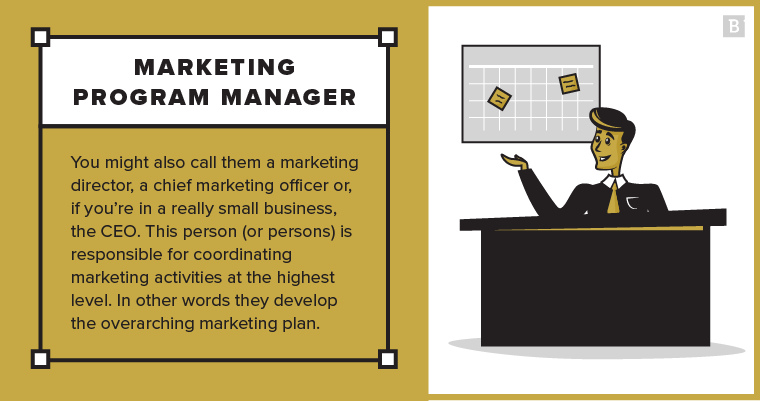
You might also call them a marketing director, a chief marketing officer or, if you’re in a really small business, the CEO. This person is responsible for coordinating marketing activities at the highest level. In other words, they develop the overarching marketing plan.
They need to understand the business goals and the barriers to achieving those goals. This includes having a solid sense of the political, economic, social and technological landscape. We call this PEST. They also need to understand their brand’s strengths, weaknesses, opportunities and threats (SWOT).
In addition to SWOTing PESTs, your marketing program manager advocates for a budget. That could be easy or very difficult depending on the organizational structure.
A Marketing Strategist
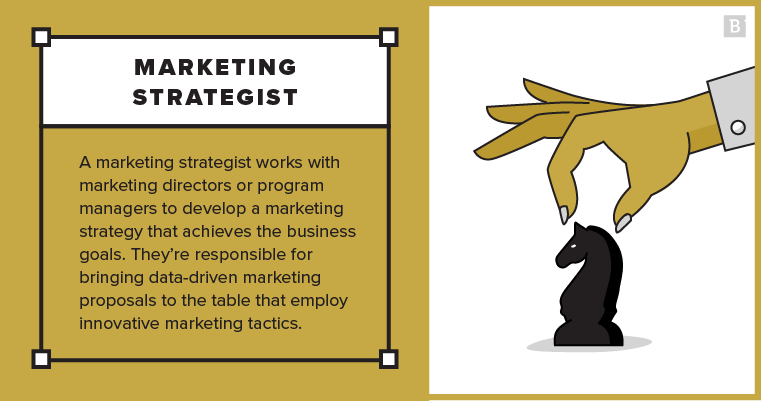
A marketing strategist works with marketing directors or program managers to develop a marketing strategy that achieves the business goals. They’re responsible for bringing data-driven marketing proposals to the table.
Marketing strategists are very near the top of the marketing food chain, so to speak. And while they don’t want to get too in the weeds, they need to be well-versed in marketing best practices and have a finger on the pulse of all things marketing technology.
As such, these experts usually have an MBA, a marketing major from a respectable college or university or a heck of a lot of experience. (Especially in the frontier that is digital marketing, many of the most prolific marketers learned by rolling up their sleeves and doing the job themselves.)
Marketing strategists should also be collaborating with sales managers. We can’t stress this enough. The insights provided by sales teams to marketing professionals can go such a long way toward refining what approach marketers take as they attempt to build messaging that relates to their target audience and yield desired business outcomes.
Finally, marketing strategists are on the hook for tracking the success of their campaigns and demonstrating ROI to their higher-ups (or to the client, if you’re a strategist at an agency).
Project Managers
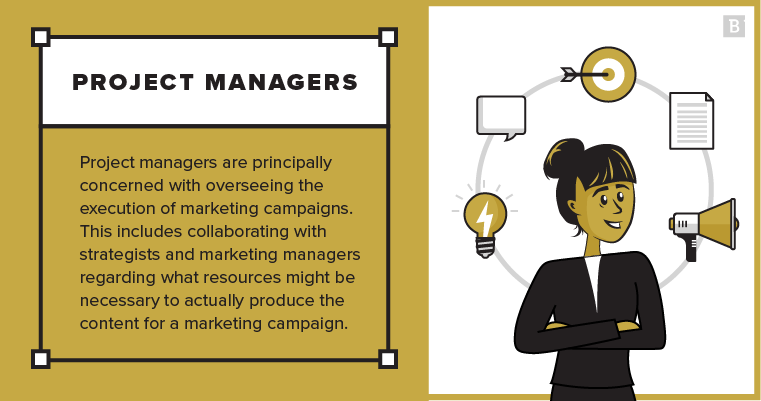
Project managers are principally concerned with overseeing the execution of marketing campaigns. This includes collaborating with strategists and marketing managers regarding what resources might be necessary to actually produce the content for a marketing campaign.
But PMs straddle the line between strategy and production. They need to be able to clearly convey strategy to the content creators, advertisers, writers, designers, consultants and developers who will actually be doing the bulk of the work. They also need to coordinate these activities, and ideally, make sure that they’re all on budget, on time and on point.
A Production Team
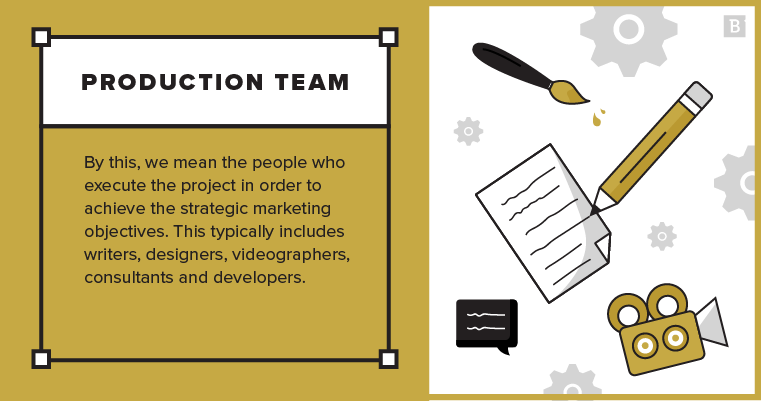
By this, we mean the people who execute the project in order to achieve the strategic marketing objectives. This typically includes writers, designers, videographers, consultants and developers.
Marketing programs might use some combination of in-house talent, freelancers, contractors and agency help. Of these options, in-house and agency models tend to be preferable from a quality control standpoint. While freelancers and contractors may come with a lower price tag, it’s more challenging to really embed them into the team.
That said, which option you choose will ultimately come down to the nature of the project, your budget and how much time your in-house marketers actually have. Working with an agency, for example, is nice because — in addition to creative and technical talent — you get access to their strategists, who can help develop data-driven marketing strategies.
2. Some Sort of Marketing Framework
The second thing that every marketing program needs is a solid marketing framework that helps them execute their marketing plan.
First, let’s clear something up.
Your marketing plan is your bigger marketing strategy, as determined by your high-level marketing managers.
Your marketing framework is your structural representation of how that plan is implemented.
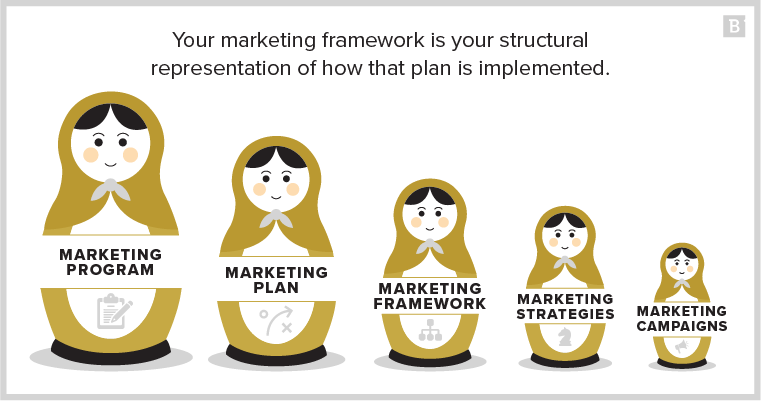
A lot of it is semantics. But the point is, you need a structured approach to executing your marketing plan, and we have a favorite:
The Inbound Marketing Framework
Otherwise known as the sales and marketing funnel (or pull marketing), the inbound marketing framework is a model for digital marketing that automates the flow of leads to your sales team. It relies heavily on content marketing and search engine optimization for success to move leads and prospects through the customer journey.
At a high level, the framework can be broken down into a few key phases:
Lead Generation
You might also call this phase brand awareness. At the risk of splitting hairs, awareness is basically just generating traffic to your site, whereas lead generation is about sparking a relationship with that traffic by capturing an email address.
The tactic is mostly the same for both: You’re using blog posts, videos, infographics, tips and tricks and other content that’s actually useful to your target audience and adds value to their day.
If your audience likes what they see, they may be enticed to sign up for your newsletter, or perhaps download an asset that pertains to whatever it is they’re reading. For example, here’s a template we created to help companies build their own marketing framework:
The other part of lead generation is making sure that your website is optimized to perform on search. This requires conscripting consultants and developers to nail technical SEO elements like:
- Page speed.
- Metadata.
- Schema markup.
- Site health.
- User experience (UX).
It also entails optimizing content such as your blog posts, landing pages, etc. so that it’s all discoverable via search.
For instance, at Brafton, our strategists anticipate what our target audience searches for by performing keyword research with tools like SEMrush. We map high-volume keywords to the top-performing content on the web, analyze that content and then create better content.
The goal is to pull traffic away from our competitors’ sites and onto our own.
And for that, we have an internal content marketing program that calls upon the talents of strategists, project managers, writers, designers, videographers, consultants and developers — all of whom are provided with the technology they need to execute their respective activities.
Lead Nurturing
At this phase, you have a lead, and now you need a way to drive them deeper into the funnel.
How? By promoting useful content straight to their email inbox and on social media. Some examples of lead-nurturing content include:
An Email Newsletter:
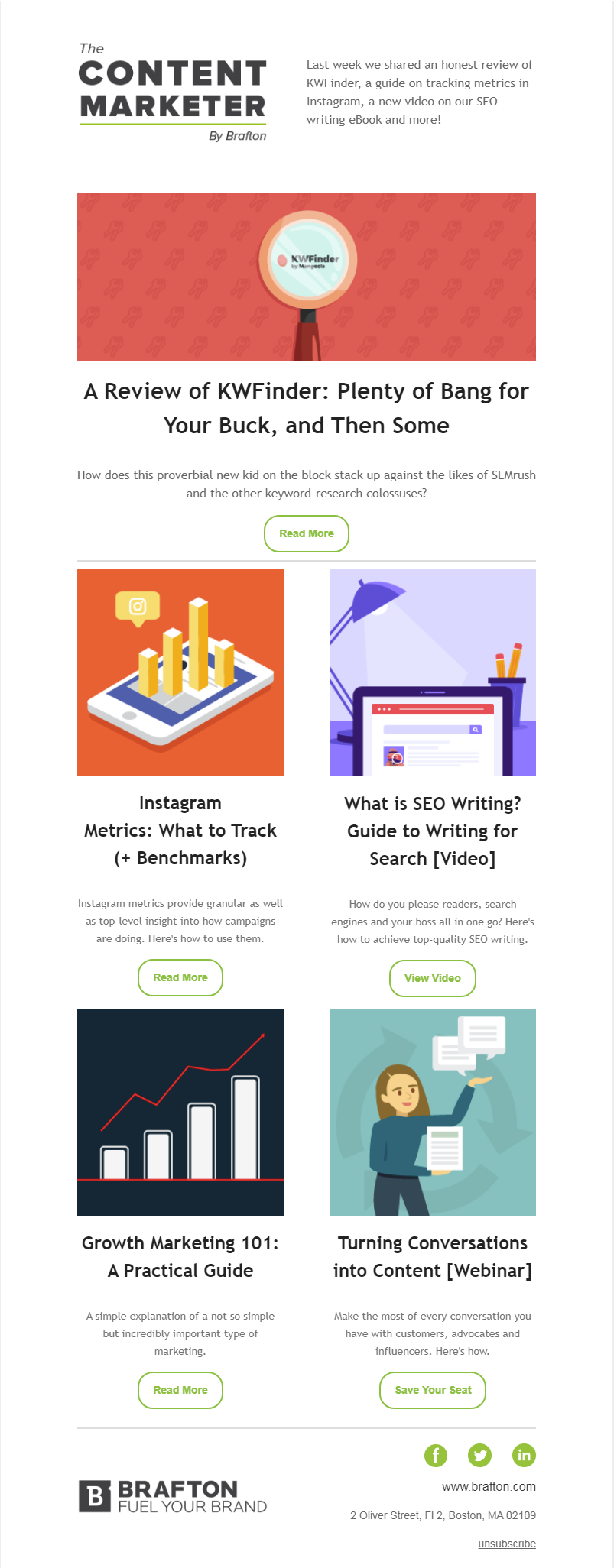
Webinars:
eBooks:
Original Research:
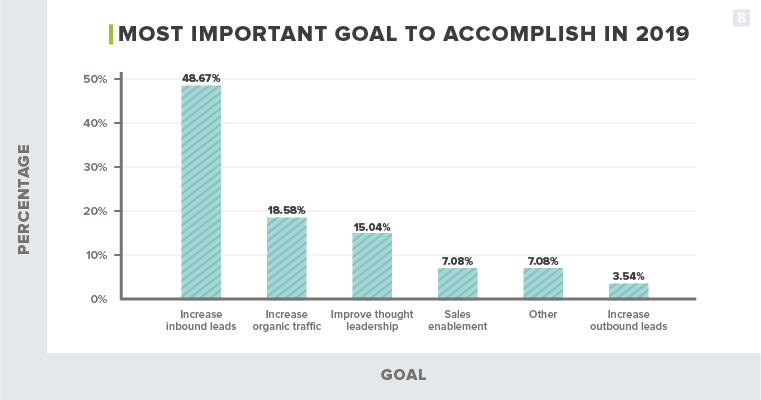
Other viable lead-nurturing tactics include white papers, infographics, video animations and other content that will demonstrate your brand’s value, and ultimately convert a lead into a prospect.
Sales Enablement
By sales enablement, we really mean bottom-of-funnel content that helps drive sales. This might include:
Case Studies:
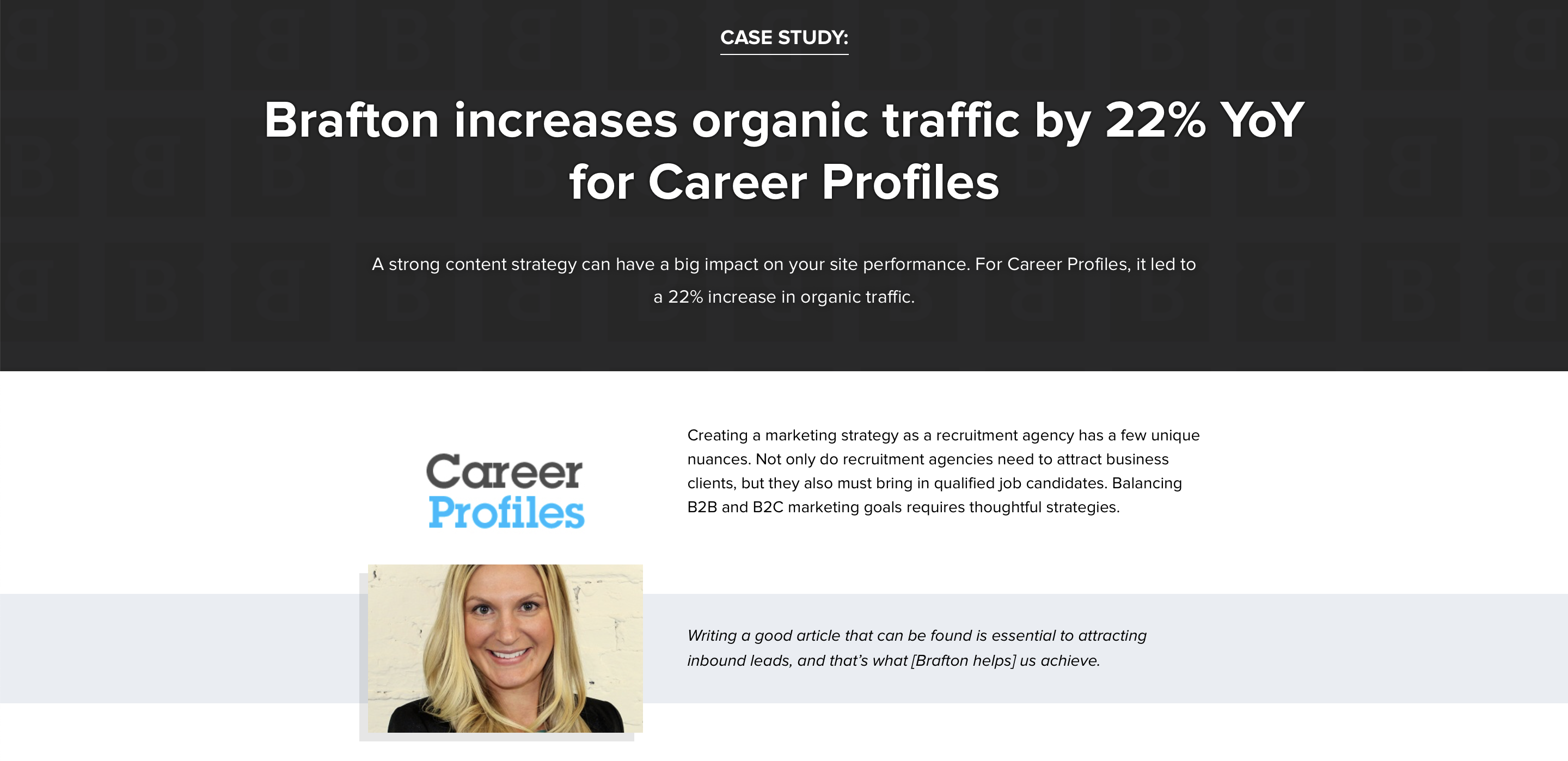
Video Testimonials:
Product or Service Demos:
Other sales enablement content is entirely internal. For instance, a slide deck that indexes all of your customer success stories that your sales teams can refer to in preparation for prospect meetings.
Customer Loyalty and Brand Advocacy
There are two core objectives of this final stage of the inbound marketing framework:
- Improve customer loyalty with FAQ pages, product tutorials and other content that will improve their experience with your brand.
- Turn loyal customers into brand advocates by recruiting them for video testimonials and case studies and encouraging them to provide positive feedback on social media, online business directories and review sites.
Great People + A Strong Foundation = A Great Marketing Program
People are at the heart of marketing in more ways than one. They’re the creators as well as the ones who benefit from the creation; they are the teams who build your marketing strategy and the potential or current customers who see it in action and, as a result, decide to engage with your brand. That’s why people are the first thing you need for any digital marketing or content marketing strategy.
Every marketing program starts with knowledgeable people who can help you track ROI, implement a framework that is best suited to your marketing plan, develop winning strategies and deliver content that achieves your goals — whether that’s to oust an autocrat or just improve your bottom line.
The second thing you need is a strong foundation. That means you need to have the consumer behavior and marketing research data to drive your decisions. However, perhaps more importantly, you also need the flexibility to adapt to new marketing channels and find new ways of leveraging existing ones.
Oh, and one more thing: You need a little inspiration, too. Luckily, there’s plenty of that to go around. Subscribe to our newsletter for all the tips and tricks you need to support your people, create a strong foundation and become a marketing leader in your industry (and maybe even the world).
Editor’s Note: Updated June 2022.








